 |
JAMES BOND FACT FILES |
 |
JAMES BOND FACT FILES |
|
|||||||||||||||||||||||
|
|||||||||||||||||||||||
|
The enormous worldwide box-office success of Goldfinger (1964) meant that more companies were seeking a licence to manufacture James Bond related products, with others continuing their association with the character in the fourth film Thunderball, released to even greater success in late 1965. In 1964 DANJAQ S.A. and Glidrose Productions had teamed up with English sales consultant Julian Mervyn Brodie (1925-1993) who handled the licensing of James Bond related products in return for a share of the royalties. The arrangement with the company Mervyn Brodie & Associates Ltd. remained in place for several subsequent films until Glidrose and DANJAQ took over handling the licensing themselves. Under the terms of the licensing agreement companies ensured that there must be no endorsement or implied endorsement of any products or service which could be attributed to Sean Connery or any other artist in the film. Among the first products licensed were the 1964 souvenir book James Bond In Focus, and 1965 James Bond Annual which was not featured in the Exhibitors’ Campaign Book for Goldfinger or Thunderball. |
|||||||||||||||||||||||
|
|||||||||||||||||||||||
|
One of the most unusual marketing tie-ins in the James Bond film series was a 1965 promotion with the home appliance manufacturer Frigidaire - the only one listed in the Exhibitors’ Campaign Book for the first 007 double-bill in the UK. The linking of the tag-line of ‘Double-DOUBLE-O-SEVEN’ with a Double-Action twin tub washing machine was tenuous to say the least! A 28" X 20" Showcard was produced, and local Frigidaire stockists were encouraged to display their newly-launched twin-tub washing machine in showroom windows, along with posters and stills to promote the double-bill a week before the films screened in towns and cities across the UK from November 7, 1965. |
|||||||||||||||||||||||
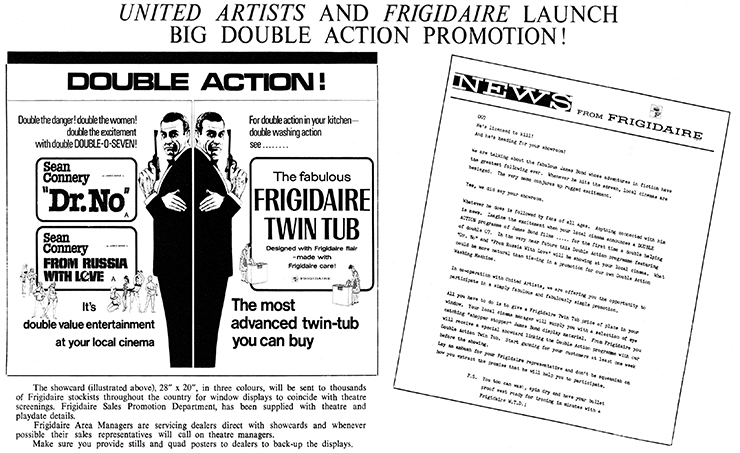 |
|||||||||||||||||||||||
|
|
|||||||||||||||||||||||
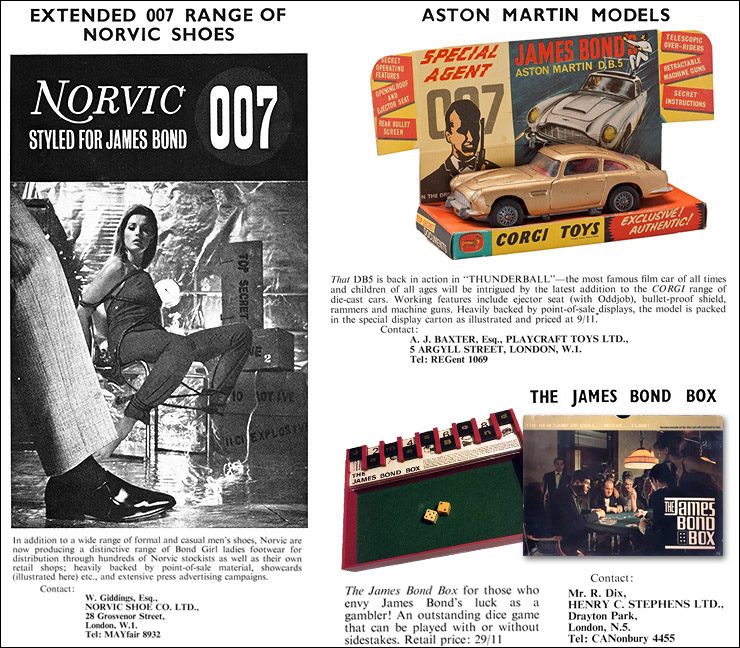 |
|||||||||||||||||||||||
|
Following their successful Goldfinger tie-in campaign, The NORVIC SHOE CO. LTD. extended their range to include ladies’ footwear for the release of Thunderball (1965). Once again their campaign was backed by point-of-sale material, showcards and extensive press advertising. Perhaps the most important tie-in of all was with CORGI Toys, who produced a scale model of James Bond's Aston Martin DB5 (complete with working features). Although the packaging stated that the car was ‘From the James Bond Film “Goldfinger”’, it was actually issued two months before Thunderball hit the big screen in the UK. Curiously the original 1965 CORGI Aston Martin DB5 was issued in a gold finish instead of the Silver Birch of the film version. It was not until January 1968, that CORGI re-issued the Aston Martin DB5 in the correct silver livery, and with even more special features. The decision to release the original DB5 with gold paint was taken by CORGI management as it felt that customers would think a silver version would look unfinished. Despite this, a Silver Birch edition was illustrated on the box, and used in some advertising for the toy when it was originally issued. Priced at 9/11 (the equivalent of 50p in decimal currency), the toy wasn't inexpensive by the standards of the day. The DB5 was an instant success following a huge promotional campaign, and went on to win awards for ‘Toy of the Year’ and ‘Best Boys Toy’ of 1965 at the January 1966 British Toy Fair. Having no connection to Thunderball in any way, “The James Bond Box” was a dice game made by Henry C. Stephens Ltd. – a long-established London company better known as a manufacturer of ink and writing equipment. The game was distributed as a Waterman branded product. The famous luxury pen manufacturer had been acquired by Henry C. Stephens Ltd. in 1964. |
|||||||||||||||||||||||
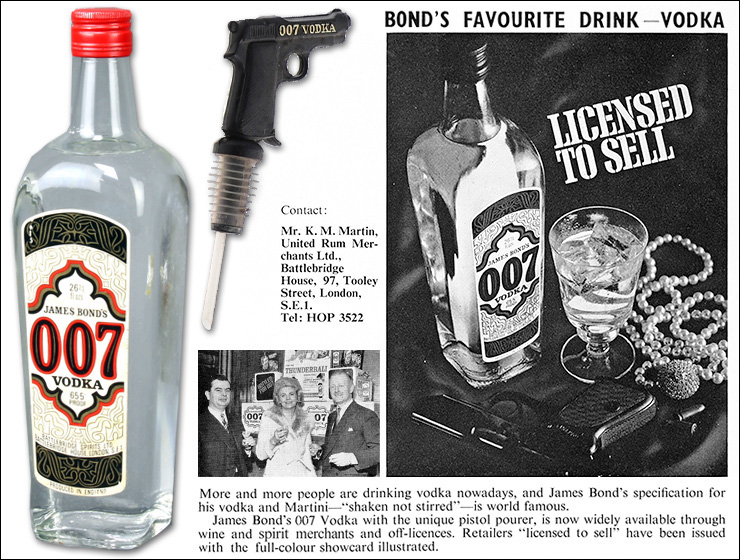 |
|||||||||||||||||||||||
|
Another luxury item to be released to tie-in with the release of Thunderball (1965) was “James Bond's 007 Vodka”. The 65.5 percent proof alcohol came in a special branded bottle with a unique pistol pourer, and advertised with a full-colour showcard. Following the press screening of Thunderball at the ODEON Leicester Square on Tuesday December 28, 1965, press representatives were invited to a “007 Vodka reception” where guests sampled the ‘Thunderball cocktail’ [pictured above]. |
|||||||||||||||||||||||
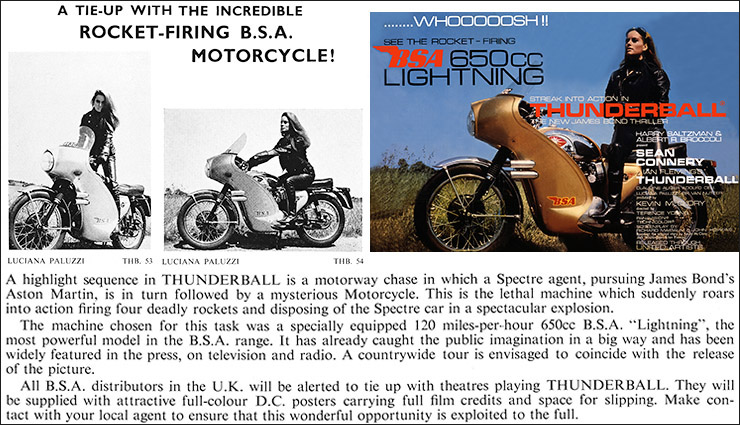 |
|||||||||||||||||||||||
|
|||||||||||||||||||||||
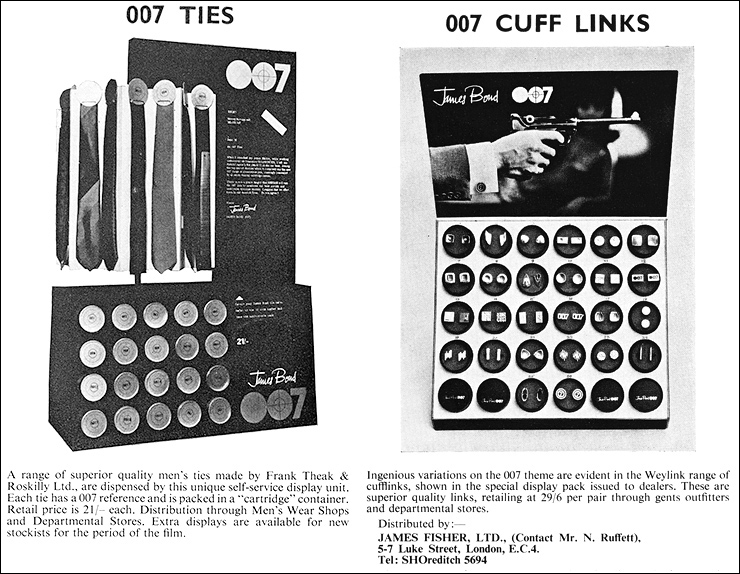 |
|||||||||||||||||||||||
|
Among the other clothing items aimed at the more adult James Bond fan were “James Bond 007” ties and cuff links. The British company James Fisher Ltd. were granted a licence to manufacture these products, although they were not directly linked to Thunderball (1965) but were available from stockists for the period the film was on release in the UK. There were 26 different styles of Weylink cuff links, each designed on a variation of the 007 theme. These were supplied in a “James Bond 007” branded box, and retailed at 29/6 per pair. |
|||||||||||||||||||||||
 |
|||||||||||||||||||||||
|
|||||||||||||||||||||||
 |
|||||||||||||||||||||||
|
In late 1965 Lone Star packaged realistic replicas of James Bond's famous guns in a “suitcase kit” containing the gold-handled pistol, golden holster, 007 badge, telescopic rifle, binoculars, and grenades. Measuring 6.25" long without the silencer, the pistol was repurposed in several gift sets in subsequent years, eventually ending up as a tie-in with The Man With The Golden Gun (1974) due to its golden handle. The “suitcase kit’ was well advertised in several children's comics in late 1965. |
|||||||||||||||||||||||
 |
|||||||||||||||||||||||
|
Also aimed at children was a novelty hat with a simple plastic hatband with the words “James Bond”, “007” and “ to Kill” boldly printed in white and gold. Presumably, these were an existing novelty felt hat and it was just a matter of producing the cheaply manufactured two-coloured hatbands. An example can be seen [pictured above right] in the 1965 short promotional film A Child's Guide To Blowing Up A Motor Car written and narrated by English comedy writer and television presenter Dennis Norden (1922-2018) for the Ford Motor Company Ltd. |
|||||||||||||||||||||||
|
|||||||||||||||||||||||
|
A clever promotion linking the name ‘Bond’ with Premium Savings Bonds was launched in February 1966 when the top prize in the ‘ERNIE’ ( Electronic Random Number Indicator Equipment) draw was increased to £25,000. A full-page advertisement [pictured below left] for the draw also appeared in the February 1966 issue of available in cinemas on the Rank Distribution Circuit as Thunderball was on general release in the UK. A clever promotion linking the name ‘Bond’ with Premium Savings Bonds was launched in February 1966 when the top prize in the ‘ERNIE’ (Electronic Random Number Indicator Equipment) draw was increased to £25,000. A full-page advertisement [pictured below left] for the draw also appeared in the February 1966 issue of SHOWTIME magazine available in cinemas on the Rank Distribution Circuit as Thunderball was on general release in the UK. |
|||||||||||||||||||||||
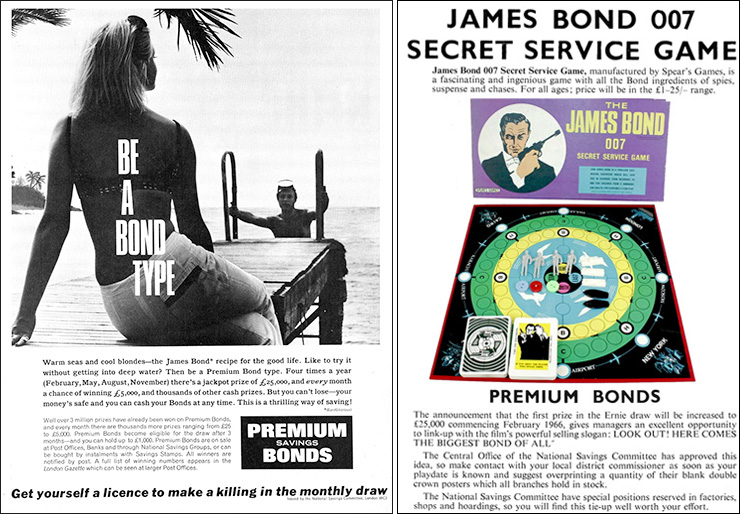 |
|||||||||||||||||||||||
|
“The James Bond 007 Secret Service Board Game” from Spear's Games appeared in stores ready for the Christmas market. The object of the game (designed for two to four players) was to obtain a suitcase with a secret formula, placed in the middle of the board. The player moves with one of the 9 cards which are dealt initially. If the player uses a card, he/she gets another one from the deck. If one player has the suitcase, the others try to intercept it. The one who gets the suitcase back to his base, wins. The set came with 72 cards, 4 Boats, 4 Cars, 1 Case, 4 James Bond Figures, and the Game Board. |
|||||||||||||||||||||||
|
|||||||||||||||||||||||
|
Hot on the heels of their controversial 1964/65 James Bond Chewing Gum set, Somportex issued a new series of cards to tie-in with the release of Thunderball (1965). This time increased to 72 cards (although the Exhibitors’ Campaign Book stated there would be 50) but with just two cards in each pack, this meant even more potential revenue as collectors aimed to acquire the full set. The “James Bond in Thunderball” cards proved equally controversial as the original release, and card No. 24 which showed James Bond supposedly hitting a woman was withdrawn and replaced with a non-violent image from the Junkanoo sequence [ROLLOVER]. In Thunderball, the ‘woman’ was actually a man (stuntman Bob Simmons playing Colonel Jacques Bouvar), and the still was a posed publicity shot of Sean Connery supposedly delivering a right-hook to actress Rose Alba’s chin (she portrayed the veiled character up to the point of being unmasked by 007). Six further cards were replaced in later printings when it was felt that more images from the film rather than publicity photos was more appropriate. When the cards were originally issued scenes from the Junkanoo sequence and climactic underwater battle were not available. Additionally, cards No. 1 and No. 3 had the caption above the descriptive text on the rear transposed, so these two were also reprinted with the proper title to accompany Fiona on her B.S.A. motorcycle as “Rockets on the Road” and “Fast Agent”. This meant the total number of unique cards now totalled 80, although many of these anomalies did not come to light until many years later. |
|||||||||||||||||||||||
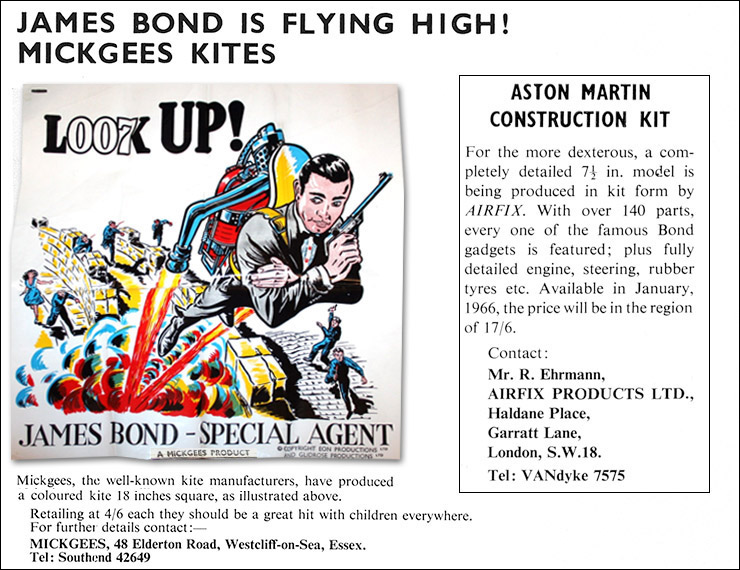 |
|||||||||||||||||||||||
|
|||||||||||||||||||||||
|
The full-sized Aston Martin was also still a powerful marketing tool following its spectacular debut in Goldfinger (1964). Although the car appeared in Thunderball (1965) the film did not showcase the gadgets as prominently in the new film, it was clearly still inextricably linked with the character of James Bond following a promotional tour by Mike Ashley, European Sales Manager of Aston Martin Lagonda, who took one of the four specially modified vehicles around the world to promote Goldfinger in 1964/65. |
|||||||||||||||||||||||
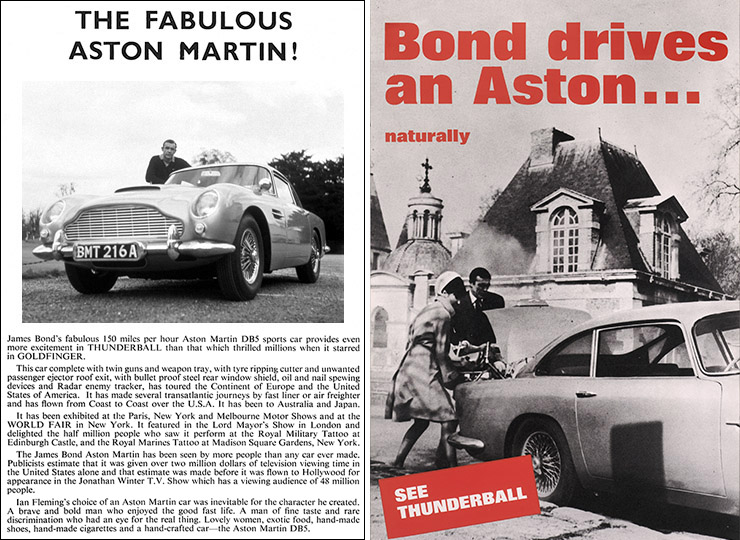 |
|||||||||||||||||||||||
|
On December 3, 1964, the Aston Martin left Southampton Docks and was shipped across the Atlantic aboard the S.S. France, and even this became a newsworthy event [pictured below left]. After the six-day voyage, 24-year-old Mike Ashley then drove the car along Broadway for the US Premiere of Goldfinger at the De MILLE Theatre in New York in New York on December 21, 1964. The Aston Martin was later displayed at the New York City World’s Fair in 1965 [pictured below right]. Aston Martin produced a Double-crown (20" X 30") to promote the car's appearance in Thunderball (1965) [pictured above right]. |
|||||||||||||||||||||||
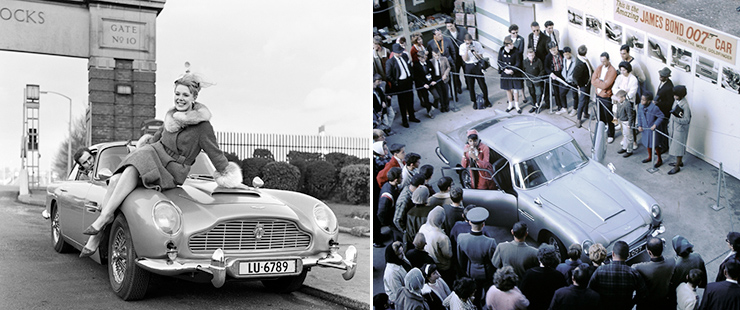 |
|||||||||||||||||||||||
|
Not illustrated in the Exhibitors’ Campaign Book for Thunderball (1965) was a set of four 375-piece jigsaws from Arrow Games featuring two paintings by prolific British illustrator Walter Howarth (1928-2008). Howarth’s artwork depicted scenes from Goldfinger (1964) and From Russia With Love (1963); while the other two reproductions were *Thunderball (1965) poster artworks – Look Up! and Look Down! by Frank McCarthy. *Howarth also painted in the area at the top of the Look Up! artwork, which originally did not picture the chateau from which 007 is escaping [ROLLOVER IMAGE BELOW]. |
|||||||||||||||||||||||
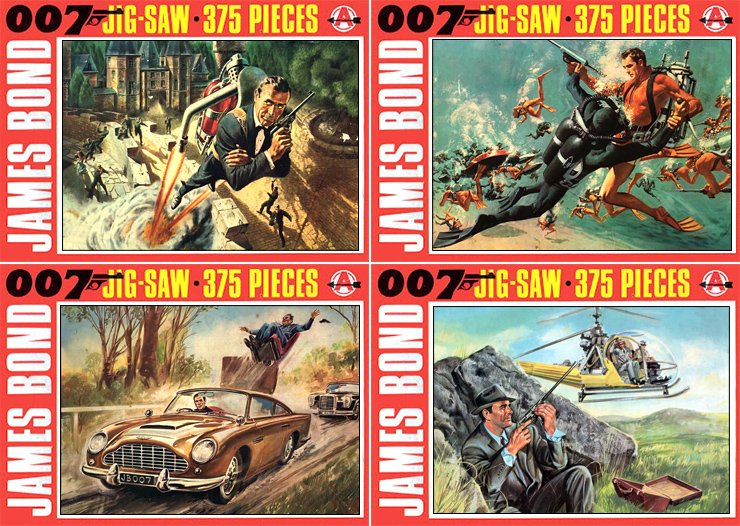 |
|||||||||||||||||||||||
|
|||||||||||||||||||||||
|
|
|||||||||||||||||||||||
 |
|||||||||||||||||||||||
|
|||||||||||||||||||||||